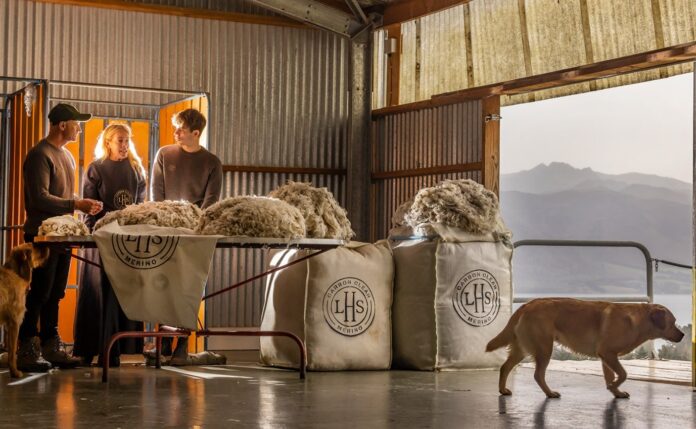Source: MakeLemonade.nz
Ōtepoti – Lake Hawea Station in Otago, run by Justine and Geoff Ross, is Australasia’s first certified carbon positive farm.
The 6500 hectare station, which has close to 10,000 merino sheep and 200 angus cows, can be found on the eastern side of Lake Hawea in Central Otago.
The station primarily operates as a sheep and beef farm, with merino wool, angus beef and lamb as key products, but the farm also offers accommodation, an events space, eco and agriculture tours, honey, mountain biking, and e-bike tours, all under the farm’s carbon clear brand.
As part of their certification through the toitu programme, the farm’s emissions are calculated, reduced where possible, and the remainder are offset on farm through regenerating natives. The farm is certified as carbon positive, but the goal is to get to 10x carbon positive.
A key part of that goal will be transitioning away from fossil fuels, which the farm is already working on. Right now, they’re trialling electric farm bikes and are working on switching machinery to electric or hydrogen powered. They’re also planning to get an electric tractor as soon as one is available.
The Rosses have invested in solar for their electric fencing, lighting, gates, and dog kennel compound. It’s a large system, similar to the Tesla powerwall, with a battery system that stores any excess power.
Given Lake Hawea Station is a farm, one of the first challenges the Ross’s face is methane emissions. Almost 71 percent of CO2 equivalent emissions from Lake Hawea Station are due to methane, so reducing it is part of their plan.
They are looking at carbon sequestering properties of seaweed. They are also looking into the potential for regenerative pastures to reduce emissions and including soil and tussock in the carbon calculations which would push them further towards their 10x carbon positive goal.
Biodiversity and regenerative agriculture are a big focus. To date, the farm has fenced off all 7km of its lakefront and the main creek areas, and planted strips of native trees, which not only improves biodiversity, but also keeps stock away from waterways and provides shelter and shade.
The farm has just hired its first head of ecology and soil, focused on the farm’s nursery and planting programmes.
A total of 14,000 trees have already been planted, but the goal is to plant 100,000. They have also remapped all their vegetation to make sure they’re on track to reaching their 10x carbon positive goal. The Toitu certification found the farm currently locked up well over 3966 tonnes of carbon through extensive tree planting and areas of regenerating bush.
Ōtepoti – Lake Hawea Station in Otago, run by Justine and Geoff Ross, is Australasia’s first certified carbon positive farm.
The 6500 hectare station, which has close to 10,000 merino sheep and 200 angus cows, can be found on the eastern side of Lake Hawea in Central Otago.
The station primarily operates as a sheep and beef farm, with merino wool, angus beef and lamb as key products, but the farm also offers accommodation, an events space, eco and agriculture tours, honey, mountain biking, and e-bike tours, all under the farm’s carbon clear brand.
As part of their certification through the toitu programme, the farm’s emissions are calculated, reduced where possible, and the remainder are offset on farm through regenerating natives. The farm is certified as carbon positive, but the goal is to get to 10x carbon positive.
A key part of that goal will be transitioning away from fossil fuels, which the farm is already working on. Right now, they’re trialling electric farm bikes and are working on switching machinery to electric or hydrogen powered. They’re also planning to get an electric tractor as soon as one is available.
The Rosses have invested in solar for their electric fencing, lighting, gates, and dog kennel compound. It’s a large system, similar to the Tesla powerwall, with a battery system that stores any excess power.
Given Lake Hawea Station is a farm, one of the first challenges the Ross’s face is methane emissions. Almost 71 percent of CO2 equivalent emissions from Lake Hawea Station are due to methane, so reducing it is part of their plan.
They are looking at carbon sequestering properties of seaweed. They are also looking into the potential for regenerative pastures to reduce emissions and including soil and tussock in the carbon calculations which would push them further towards their 10x carbon positive goal.
Biodiversity and regenerative agriculture are a big focus. To date, the farm has fenced off all 7km of its lakefront and the main creek areas, and planted strips of native trees, which not only improves biodiversity, but also keeps stock away from waterways and provides shelter and shade.
The farm has just hired its first head of ecology and soil, focused on the farm’s nursery and planting programmes.
A total of 14,000 trees have already been planted, but the goal is to plant 100,000. They have also remapped all their vegetation to make sure they’re on track to reaching their 10x carbon positive goal. The Toitu certification found the farm currently locked up well over 3966 tonnes of carbon through extensive tree planting and areas of regenerating bush.



